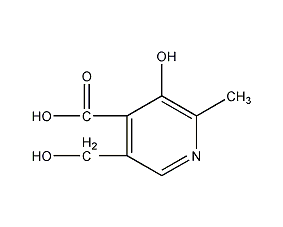4-pyridoxic acid

Structural formula
| Business number | 01T6 |
|---|---|
| Molecular formula | C8H9NO4 |
| Molecular weight | 183.16 |
| label |
2-Methyl-3-hydroxy-4-carboxy-3-hydroxymethylpyridine, 3-hydroxy-5-(hydroxymethyl)-2-methyl-4-pyridinecarboxylic acid, 2-Methyl-3-hydroxy-4-carboxy-5-hydroxymethylpyridine, 3-Hydroxy-5-(hydroxymethyl)-2-methyl-4-pyridinecarboxylic acid |
Numbering system
CAS number:82-82-6
MDL number:MFCD00006334
EINECS number:201-440-8
RTECS number:NS1800000
BRN number:None
PubChem number:24899046
Physical property data
1. Character: wedge-shaped crystal
2. Density (g/mL,25/4℃):1.72
3. Relative vapor density (g/mL ,Air=1): Unsure
4. Melting point (ºC): 247 ~248
5. Boiling point (ºC,Normal pressure): Unsure
6. Boiling point (ºC,5.2kPa): Unsure
7. Refractive index: Uncertain
8. Flashpoint (ºC): Unsure
9. Specific optical rotation (º): Unsure
10. Autoignition point or ignition temperature (ºC): Unsure
11. Vapor pressure (kPa,25ºC): Unsure
12. �� and vapor pressure (kPa,60ºC): Unsure
13. Heat of combustion (KJ/mol): Unsure
14. Critical temperature (ºC): Unsure
15. Critical pressure (KPa): Unsure
16. Oil and water (octanol/Log value of water) partition coefficient: Uncertain
17.Explosion limit (%,V/V): Unsure
18. Lower explosion limit (%,V/V): Unsure
19. Solubility: soluble in alkaline aqueous solution, slightly soluble in water, ethanol, pyridine, insoluble in ether and acidic aqueous solution
Toxicological data
Acute toxicity:
Rat caliber LD50: 7500 mg/kg; rat subcutaneous LD50 : 5400 mg/kg; rat intravenous LD50: 2050 mg/kg
Mouse caliber LD50: 2900 mg/kg; Mouse subcutaneous LD50 : 2500 mg/kg; mouse intravenous LD50: 500 mg/kg
Ecological data
None yet
Molecular structure data
1. Molar refractive index:44.43
2. Molar volume (m3/mol):123.7
3. isotonic specific volume (90.2K):369.7
4. Surface Tension (dyne/cm):79.8
5. Polarizability(10-24cm3):17.61
Compute chemical data
1. Reference value for hydrophobic parameter calculation (XlogP): 0.1
2. Number of hydrogen bond donors: 3
3. Number of hydrogen bond acceptors: 5
4. Number of rotatable chemical bonds: 2
5. Number of tautomers: 4
6. Topological molecule polar surface area 90.6
7. Number of heavy atoms: 13
8. Surface charge: 0
9. Complexity: 197
10. Number of isotope atoms: 0
11. Determine the number of atomic stereocenters: 0
12. Uncertain number of atomic stereocenters: 0
13. Determine the number of chemical bond stereocenters: 0
14. Number of uncertain chemical bond stereocenters: 0
15. Number of covalent bond units: 1
Properties and stability
has unique blue fluorescence,pH3~4 is the largest and reacts with bisulfite to fluoresce disappears, and reacts with hydrogen peroxide to return to the original fluorescence intensity.
Storage method
Should be sealed in0℃The following is stored dry. SPAN>
Synthesis method
None yet
Purpose
Organic synthesis. Biochemical research.
extended-reading:https://www.newtopchem.com/archives/1114
extended-reading:https://www.newtopchem.com/archives/179
extended-reading:https://www.bdmaee.net/sponge-hardener/
extended-reading:https://www.morpholine.org/catalyst-pc41/
extended-reading:https://www.cyclohexylamine.net/nn-diisopropylethylamine-cas7087-68-5/
extended-reading:https://www.bdmaee.net/wp-content/uploads/2022/08/129-4.jpg
extended-reading:https://www.newtopchem.com/archives/category/products/page/58
extended-reading:https://www.bdmaee.net/n-butanol-cas71-36-3/
extended-reading:https://www.newtopchem.com/archives/category/products/rigid-foams-catalyst
extended-reading:https://www.cyclohexylamine.net/catalyst-1027-polyurethane-catalyst-1027/


